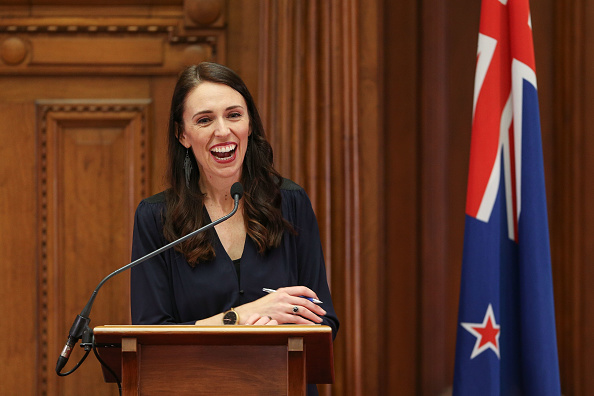Jacinda Ardern – Prime Minister of New Zealand

Jacinda Ardern, in full Jacinda Kate Laurell Ardern, (born July 26, 1980, Hamilton, New Zealand), New Zealand politician who in August 2017 became leader of the New Zealand Labour Party and then in October 2017, at age 37, became the country’s youngest prime minister in more than 150 years.
Early Life And Start In Politics:
The second of two daughters born to a Mormon family, Ardern spent her first years in Murupara, a small town best known as a centre of Maori gang activity, where seeing “children without shoes on their feet or anything to eat for lunch” inspired her to eventually enter politics. Her father—a career law-enforcement officer who later (2014) became the New Zealand government’s high commissioner to the island of Niue—moved his family to Morrinsville, southeast of Auckland on New Zealand’s North Island, where Ardern attended primary and secondary school. She matriculated to the University of Waikato in 1999.
Even before earning a bachelor’s degree in Communication Studies (2001), Ardern began her association with the Labour Party. In 1999, at age 17, she joined the party and, with the help of an aunt, became involved in the reelection campaign of Harry Duynhoven, a Labour member of parliament (MP) in the New Plymouth district. Following graduation, Ardern became a researcher for another Labour MP, Phil Goff. That experience would lead to a position on the staff of Prime Minister Helen Clark, the second woman to hold New Zealand’s highest office and Ardern’s political hero and mentor.
In 2005 Ardern embarked on an “overseas experience,” an extended—usually working—trip to Britain, which is a traditional rite of passage for the children of New Zealand’s middle and upper class. Instead of labouring in a London pub or warehouse and then touring the Continent, however, Ardern worked for two and a half years in the cabinet office of British Prime Minister Tony Blair, serving as an associate director for Better Regulation Executive with the primary responsibility of improving the ways in which local authorities interact with small businesses. In 2007 she was elected president of the International Union of Socialist Youth (IUSY), a position that took her to destinations such as Algeria, China, India, Israel, Jordan, and Lebanon.
In 2008 Ardern was chosen as Labour’s candidate for MP of the Waikato district, a seat that historically had been beyond the party’s reach and that Ardern lost by some 13,000 votes. Nevertheless, she entered parliament as a list candidate. New Zealand’s mixed-member proportional (MMP) election system allows candidates who run for a district seat also to be on a party’s list of candidates, from which 49 MPs are chosen in proportion to the number of votes received by their parties. At age 28 Ardern entered the House of Representatives as its youngest member. In her maiden speech, she called for the introduction of compulsory instruction in the Maori language in New Zealand schools and she castigated the New Zealand government for what she characterized as its “shameful” response to climate change. In addition to being named Labour’s spokesperson for Youth Affairs, Ardern was appointed to the Regulations Review and the Justice and Electoral select committees.
In 2011 she ran for the seat representing Auckland Central that was held by another of New Zealand politics’ brightest young stars, Nikki Kaye of the New Zealand National Party, who was just five months older than Ardern. Kaye narrowly (717 votes) won the race, dubbed the “Battle of the Babes,” but once again Ardern returned to parliament as a well-placed list candidate. Ardern’s support for David Shearer in his successful quest for Labour leadership won her a high profile assignment as Social Development spokesperson. In 2014 Ardern once again faced off with Kaye for the Auckland Central seat, this time losing by only 600 votes. Nonetheless, ensconced at the number five position on Labour’s list, Ardern easily returned to parliament. Labour leader Andrew Little expanded her portfolio to include positions as spokesperson for Arts, Culture, and Heritage, Children, Justice, and Small Business.
As Ardern’s political profile increased in prominence, the details of her personality and personal life became better known. Opposed to the Church of Jesus Christ of Latter-day Saints’ stand on homosexuality and same-sex marriage, Ardern became a lapsed Mormon. She gained notoriety by performing as a disc jockey. She was also involved in a romantic relationship with broadcast personality Clarke Gayford, who in 2016 became the host of Fish of the Day, a part-fishing, part-travel television program that took him to exotic island locales throughout the Pacific. Ardern bridled at media attention to her physical attractiveness, characterized herself as an “acceptable nerd,” and described her approach to life as “relentlessly positive.”
Ardern Becomes Party Leader:
In 2017 Ardern registered a landslide victory in the parliamentary by-election for the vacant seat representing the solidly Labour district of Mount Albert in Auckland. When Labour’s deputy leader, Annette King, announced her resignation, Ardern was unanimously elected as her replacement. Meanwhile, as the general parliamentary election scheduled for September 2017 approached, Labour’s showing in preference polling was abysmal. Even after some nine consecutive years with the National Party in power, there was seemingly little interest among voters in trying Labour Party rule. A pair of polls in July found Labour Party support to be less than 25 percent—some 6 percent worse than the party’s standing in a June polling. With fewer than two months left before the election, Little stepped down as leader but not before securing Ardern’s pledge to stand as his replacement (reportedly, she refused seven times before agreeing). Running unopposed, Ardern was elected leader on August 1.
Thus began a spirited sprint by Ardern to replace the National Party’s Bill English as prime minister. Her charismatic optimism, strength, and down-to-earth charm quickly energized voters—especially women and the young—and, in response, Labour’s preference polling numbers climbed. In terms of the issues, Ardern called for free university education, reductions in immigration, decriminalization of abortion, and the creation of new programs to alleviate poverty among children. More broadly, she promised a “fairer deal” for the marginalized. As “Jacindamania” swept the country, pundits began characterizing Ardern as a “rock star” politician in the mode of Canadian Prime Minister Justin Trudeau and former U.S. president Barack Obama.
She also became something of a feminist icon after her response to an interviewer’s question about whether she planned to have children. Initially, Ardern said that she had no problem answering the question. The next day, however, when another interviewer implied that employers had a right to know whether prospective female employees planned on taking time off from work to have children, Ardern responded much more forcefully:
I decided to talk about it, it was my choice…, but for other women it is totally unacceptable in 2017 to say that women should have to answer that question in the workplace. It is the woman’s decision about when they choose to have children. It should not predetermine whether or not they are given a job or have job opportunities.
English accused Ardern of lacking foreign policy experience and encouraged voters to look beyond the “stardust” she spread. In the event, the National Party was the biggest vote-getter, winning some 46 percent of the total (excluding special votes), and Labour’s share was about 36 percent. Based on those results, the National Party stood to hold 58 seats and Labour 45 seats, not enough for either to attain a majority, even with the Green Party’s seven seats in support of a Labour government. When the special votes (those cast by New Zealanders who were overseas or who had registered to vote on polling day) were tallied, Labour and the Green Party each gained a seat at the expense of the National Party.
Forming a coalition government:
All of this left the centre-right New Zealand First Party, which won nine seats, in the kingmaker role. New Zealand First’s 72-year-old leader, Winston Peters, kept the country in suspense for weeks as he negotiated with both the National Party and Labour over New Zealand First’s potential participation in a coalition government. Finally, on October 19, Peters went on national television to announce that he had chosen to go into a partnership with Labour that would be further dependent on “supply and confidence” support from the Greens. “Far too many New Zealanders have come to view today’s capitalism not as their friend but as their foe,” Peters said in announcing his intention to govern with Labour. Ardern found out at the same time as the rest of the country that she was about to become its 40th prime minister, and she was sworn in on October 26.
In June 2018 Ardern gave birth to her first child, a girl. She thus became the first leader of a country in nearly 30 years to give birth while in office.
The March 2019 mosque attacks in Greater Christchurch:
In March 2019 Ardern was called upon to lead and comfort her country in the wake of what she characterized as one of its “darkest days,” after an attack on a mosque in central Christchurch and another on a mosque in suburban Linwood during midday prayers on March 15 resulted in the loss of at least 50 lives and injuries to about 50 other individuals. In both cases, the assailant allegedly was a 28-year-old white supremacist Australian national who had posted a 74-page anti-immigrant manifesto on social media immediately prior to beginning his attack with assault rifles and shotguns. Before he was apprehended by police, the gunman—who had streamed the attack on the first mosque on Facebook, apparently using a head-mounted camera—had killed 42 people at the first mosque and another 8 at the second, some 3 miles (5 km) away. According to his rambling hate-filled manifesto, the alleged assailant had come to New Zealand specifically to undertake the attacks to highlight that even a place as remote as New Zealand suffered from “mass immigration.”
The anti-immigrant motivation for the attacks was especially jolting in a country with a reputation for welcoming immigrants. Indeed, Ardern had recently announced that in 2020 New Zealand would be increasing the number of immigrants it accepted annually from 1,000 to 1,500. Ardern labeled the assault a “terrorist attack.” In addressing the country, she said of New Zealand,
We were not a target because we are a safe harbour for those who hate. We were not chosen for this act of violence because we condone racism, because we are an enclave for extremism. We were chosen for the very fact that we are none of these things—because we represent diversity, kindness, compassion, a home for those who share our values, refuge for those who need it.
She then called for changes to New Zealand’s gun laws, a statement that appeared to meet with broad approval in a country where gun ownership was widespread.
White Island (Whakaari) tragedy, coronavirus pandemic response, and election to a second term:
Ardern’s compassionate but strong response to the mosque attacks earned her praise from around the world, as would her calm, measured reaction when tragedy again befell the country, in December 2019, after a volcanic explosion on remote White Island (Whakaari) claimed 21 lives. At the time of the eruption, 47 people (adventure tourists and guides) were on the uninhabited island. The image of Ardern comforting first responders with hugs became iconic.
Notwithstanding the positive perception abroad of Ardern’s leadership, many New Zealanders appeared to be less than satisfied with the prime minister’s record on tackling housing shortages and child poverty, issues that she had pledged to address. As a result the parliamentary election called for September 2020 promised to be a close one. The dynamics of the election were changed, however, by the outbreak of the coronavirus pandemic that swept the world, beginning early in 2020. Ardern and her government took a “go hard and go early” approach to the pandemic, responding fast and forcefully by halting foreign visitation to New Zealand in mid-March (becoming one of the first countries to close its borders in response to the global health threat) and imposing a strict nationwide lockdown when just over 100 cases of COVID-19 (the disease produced by the virus) had been confirmed. In the process, the country’s tourism-dependent economy sustained a historically hard blow. GDP tumbled by more than 12 percent in the June 2020 quarter, the steepest quarterly decline in the recorded history of New Zealand’s economy.
At the same time, however, this draconian public health response produced remarkable results, as New Zealand contained the outbreak quickly and thoroughly. By August the country had gone some 100 days without evidence of community spread of the virus. When cases were diagnosed in Auckland that month, the election was postponed until October, and the country was again locked down. But by the time of the election on October 17, however, the virus was again contained, having been limited to about 2,000 cases overall to date, with only 25 deaths nationwide. Mask-wearing and social distancing requirements were removed. Ardern had skillfully overseen the country’s successful response to the pandemic with a combination of science-driven hard-line policies and a deft human touch that included casual empathetic online appearances and a promise to children that the Easter Bunny and Tooth Fairy would be treated as essential workers and allowed to continue to perform their jobs.
Voters rewarded Ardern by handing her a landslide victory. Having captured some 49 percent of the vote, Labour had its best showing at the polls in a half century and stood to become the first party since the introduction of proportional representation in 1993 to be able to form a majority government without a coalition partner. Nevertheless, the Green Party, which had been part of Ardern’s ruling coalition, increased its share of the vote from 6 percent in the last election to 8 percent in that one. All of this came at the expense of the opposition National Party, which fell from 44 percent of the vote in the 2017 election to 27 percent.
In her victory speech, Ardern reached out to all New Zealanders:
We are living in an increasingly polarized world. A place where, more and more, people have lost the ability to see one another’s point of view. I hope that this election, New Zealand has shown that this is not who we are. That, as a nation, we can listen and we can debate. After all, we are too small to lose sight of other people’s perspective.







More Stories
Martin Luther King Jr.: U.S. To Honor Civil Rights Leader
Indian Air Force Day: Everything You Need To Know
10 Rare Facts You Must Know About Sachin Tendulkar